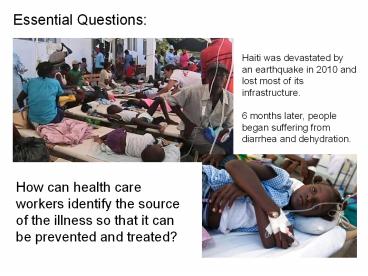Essential Questions: - PowerPoint PPT Presentation
1 / 20
Title:
Essential Questions:
Description:
... (USAMRIID) Koch's Postulates If a microorganism is the causative agent of an infectious disease, it must be: Present in every case of the disease, ... – PowerPoint PPT presentation
Number of Views:144
Avg rating:3.0/5.0
Title: Essential Questions:
1
- Essential Questions
Haiti was devastated by an earthquake in 2010 and
lost most of its infrastructure. 6 months
later, people began suffering from diarrhea and
dehydration.
How can health care workers identify the source
of the illness so that it can be prevented and
treated?
2
Pathology - the scientific study of the nature of
disease and its causes
A PATHOGEN is any disease causing agent. Quick
Exercise How many diseases can you think
of? Now watch "The A to Z of Germs..."
3
Other diseases are not contagiouscancer,
lupus, arthritis, allergiesThis unit will
focus on the first type the disease, its
agents, treatment and history and will cover
three main areas of pathology1. Viruses
(virology)2. Bacteria (bacteriology)3.
Parasites (parasitology)
some diseases are communicable, such
as anthrax, swine flu, herpes, common cold,
malaria, salmonella, AIDS
4
Definitions
- Host - organism which provides nutrients, etc. to
another organism - Parasite - organism which lives at the expense of
its host the parasite is metabolically dependent
upon it
Disease - an upset in the homeostasis of the
host, resulting in generation of observable
changes and/or damage to host
Infectious disease - disease that can be
transmitted by the host to another host or vector
5
- Symptom - evidence of damage to the host
(headache) - Virulence - a measure of pathogenicity, which is
the ability to cause disease (a microorganism
that causes disease is virulent)
6
Epidemic - when a disease affects a
community Pandemic - when a disease affects the
world
Play Pandemic 3 or Plague Inc
7
- Disease Categories Food and Waterborne -
pathogen is in a food or water source
(Cholera) - Blood Borne - carried in blood or other bodily
fluids (HIV) - Sexually Transmitted - transmitted by sexual
contact (Syphilis) - Zoonotic - carried by animals (Rabies)
- Airborne - carried by the air, often affect
respiratory tract (Influenza)
8
- Organizations Dealing with Health -
- Centers for Disease Control (CDC)
- World Health Organization (WHO)
- U.S. Department of Health and Human Services
(HHS) - U.S. Army Medical Research Institute of
Infectious Diseases (USAMRIID)
9
- Koch's Postulates
- If a microorganism is the causative agent of an
infectious disease, it must be - Present in every case of the disease, but absent
from the healthy host - Isolated and grown in pure culture
- Able to Cause the disease when a pure culture is
inoculated into a healthy host - Re-isolated from the host that was inoculated
with the pure culture
10
(No Transcript)
11
- Steps in Pathogenesis
- To cause disease, a pathogen must
- Contact the host - be transmissible
- Colonize the host - adhere to and grow or
multiply on host surfaces - Infect the host - proliferate in host cells or
tissues - Evade the host defense system - by avoiding
contact that will damage it - Damage host tissues - by physical (mechanical) or
chemical means
Image An emergency hospital ward in Kansas
during the 1918 flu
12
Edward Jenner (1796) Noting the common
observation that milkmaids did not generally get
smallpox, Jenner theorized that the pus in the
blisters which milkmaids received from cowpox (a
disease similar to smallpox, but much less
virulent) protected the milkmaids from
smallpox. Jenner tested his hypothesis by
inoculating James Phipps, a young boy of 8 years
(the son of Jenner's gardener), with material
from the cowpox blisters of the hand of Sarah
Nelmes, a milkmaid who had caught cowpox from a
cow called Blossom
13
- Ignaz Semmelweis (1850)
- Observed that women in the maternity wards died
of childbed fever. He proposed that it was caused
by doctors doing autopsies on the deceased women
and then carrying the disease causing agent to
healthy women who were in labor. - His solution Wash your hands before delivering
babies! - The Germ Theory did not exist at this time
14
- Louis Pasteur - developed the germ theory and
disproved spontaneous generation, in 1885 he
developed the rabies vaccine - Robert Koch - Koch's postulates
- Alexander Fleming - discovered penicillin, though
it wasn't until much later that it was produced
as an antibiotic
15
- Jonas Salk
- -polio vaccine
16
- 1980 - WHO declared smallpox eradicated
- 1983 - Discovering and identification of the AIDS
virus (HIV) - 1985 - First vaccine for Haemophilus influenzae
type b (HiB) 2006 - First vaccine for human
papillomavirus - Check out http//www.bt.cdc.gov/socialmedia/zombi
es_blog.asp
17
- The Germ Theory (around 1860)
- Single most important contribution by the science
of microbiology to the general welfare of the
world's people - The theory that microorganisms may be the cause
of some or all disease. - Key to developing the germ theory of disease was
a refutation of the concept of spontaneous
generation. - Specific aseptic techniques are employed to avoid
microbial contamination - Method of prevention of spoilage of liquid
foodstuffs - Pasteurization - Why is this a theory and not a fact?
18
- Essential Questions
Haiti was devastated by an earthquake in 2010 and
lost most of its infrastructure. 6 months
later, people began suffering from diarrhea and
dehydration.
Outline steps you would take to identify the
source of the infection and determine how (or if)
it is a communicable disease.
19
(No Transcript)
20
(No Transcript)































